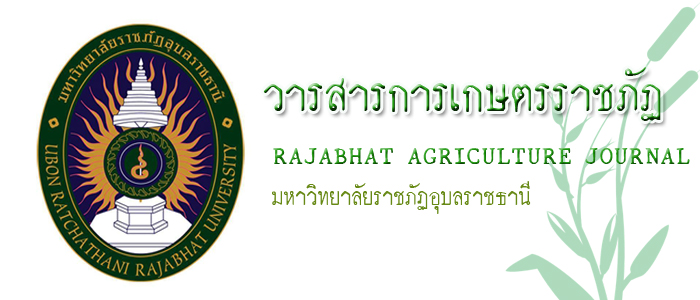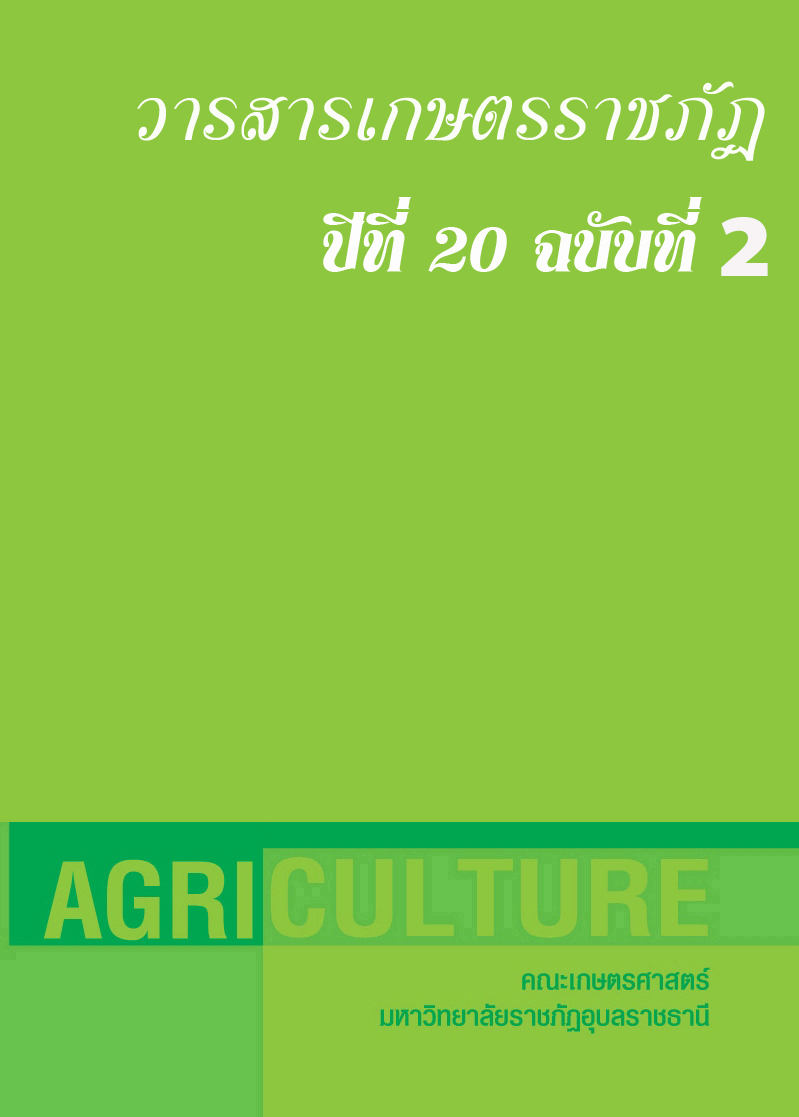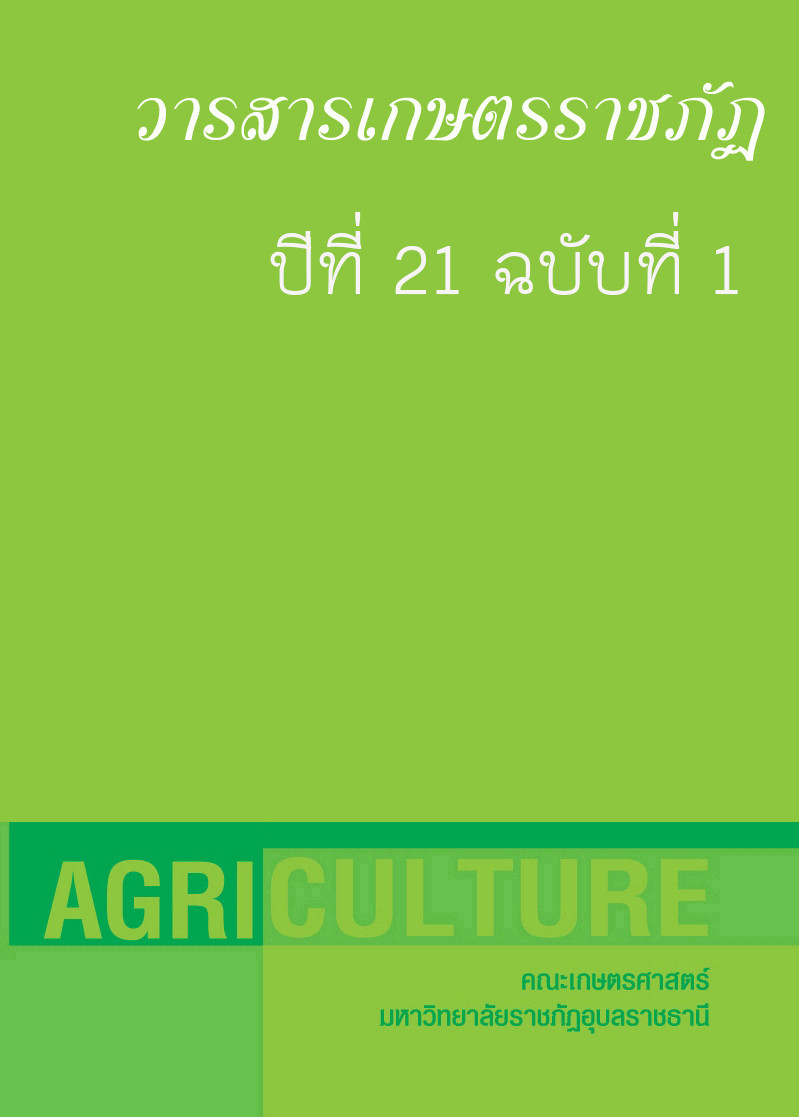
ผลของการใช้น้ำมันหอมละเหยตระไคร้และน้ำมันหอมละเหยกระดังงา ต่อองค์ประกอบของซากไก่เนื้อภายใต้โรงเรือน ที่เลี้ยงในสภาพอากาศร้อนชื้น

ผลของการใช้น้ำมันหอมละเหยตระไคร้และน้ำมันหอมละเหยกระดังงา ต่อองค์ประกอบของซากไก่เนื้อภายใต้โรงเรือน ที่เลี้ยงในสภาพอากาศร้อนชื้น
Effect of Lemon grass Essential oil (Cymbopogon Citratus Stapf) and Ylang Ylang Essential oil (Cananga odorata) application on carcass composition of broilers raised under hot and humid chicken shed
--------------------------------------------
โดย ฐิตาภรณ์ คงดี พัชรา ธนานุรักษ์ ชนณภัส หัตถกรรม ธันวา ไวยบท และ ชาญวิทย์ วัชรพุกก์
ประเภท : บทความวิจัย
ปีที่ตีพิมพ์ : วารสารเกษตรราชภัฏ ปีที่ 20 ฉบับที่ 2
ผู้เข้าชม 0
วันที่ปรับปรุงข้อมูล : 2021-12-27 08:54:45
บทคัดย่อ
การทดลองครั้งนี้มีวัตถุประสงค์เพื่อศึกษาองค์ประกอบของซากและความสามารถในการทนต่อความร้อนของไก่เนื้อลูกผสม 1,280 ตัว (C.P.707) โดยใช้แผนการทดลอง Factorial 2x4x4 ในการทดลองออกแบบสุ่มสมบูรณ์ (CRD) ของน้ำมันหอมระเหยตะไคร้ (Cymbopogon Citratus Stapf) และน้ำมันหอมระเหยกระดังงา Ylang Ylang (Cananga odorata) เกี่ยวกับองค์ประกอบของซากไก่เนื้อลูกผสมภายใต้โรงเรือนเลี้ยงไก่ในสภาพแวดล้อมที่ร้อนและชื้น โดยการผสมอาหาร - ผสมน้ำมันหอมระเหยแต่ละชนิดลงในอาหารสัตว์ที่ระดับ 0, 0.02, 0.04 และ 0.06% แล้วให้ไก่เนื้อและใช้วิธีการฉีดพ่น – ฉีดพ่นน้ำมันหอมระเหยแต่ละชนิดที่ระดับเดียวกันกับผสมในอาหาร ฉีดพ่นให้กับไก่เนื้อเป็นเวลา 1 นาทีในแต่ละวัน เปิดอัตโนมัติเวลา 14.00 น. ดำเนินการศึกษาที่ วิทยาลัยเกษตรและเทคโนโลยีชัยนาท จังหวัดชัยนาท ประเทศไทย จะเห็นได้ว่าอุณหภูมิ ภายนอกจาก Black globe (BGExt, 41.24±5.19 oC) สูงกว่าอุณหภูมิภายในจาก Black globe (BGInt, 34.41±3.48 oC) อย่างมีนัยสำคัญทางสถิติที่ระดับ (P<0.01) แสดงให้เห็นถึงผลกระทบของรังสีดวงอาทิตย์ต่อ อุณหภูมิแวดล้อม และพบว่าสหสัมพันธ์ระหว่างพารามิเตอร์ทางสรีรวิทยาของไก่เนื้อที่ได้รับน้ำมันหอมระเหย (EOs) และอัตราที่ผสมในอาหาร (M) มีนัยสำคัญทางสถิติที่ระดับ {RT (P<0.01), SknT12 (P<0.01) และ SknT14 (P<0.05)}. จะเห็นได้ว่ากลุ่มไก่เนื้อที่ได้รับ EOs ของตะไคร้ (ELG) มีน้ำหนักซาก หัวใจ ตับอ่อน และม้ามมีน้ำหนักเพิ่มขึ้นอย่างมีนัยสำคัญทางสถิติที่ระดับ {(P<0.05), (P<0.05), (P<0.05) และ (P< 0.05) ตามลำดับ} มากกว่าที่ได้รับ EOsของกระดังงา(EYL). เมื่อเปรียบเทียบกับผลของการฉีดพ่น (S) EOs ลงบนไก่เนื้อ พบว่าน้ำหนักหัวใจ (g.) ของไก่เนื้อที่ได้รับสเปรย์ความเข้มข้น 0.04% (S3, 13.69 ± 1.05) สูงกว่าที่ได้รับสเปรย์ความเข้มข้น 0.06% (S4, 10.69 ± 0.73) อย่างมีนัยสำคัญทางสถิติที่ระดับ (P<0.05) ทั้งน้ำหนักหัวใจของ (S3) และ (S4) ไม่แตกต่างกันทางสถิติกับน้ำหนักหัวใจที่ 0% (S1) และ 0.02% (S2) แม้ว่าน้ำหนักตับของ (S2, 66.56 ± 2.53) จะสูงกว่าน้ำหนักตับของ (S4, 55.94 ± 2.25) อย่างมีนัยสำคัญทางสถิติ (P<0.01) แต่ทั้งการฉีดพ่น EOs ที่ระดับ (S4) และ (S2) มีค่าไม่แตกต่างจากระดับ (S1) และ(S2) อย่างมีนัยสำคัญทางสถิติ สรุปได้ว่าการใช้ตะไคร้และกระดังงาด้วยน้ำมันหอมระเหย (EOs) ไม่ได้เพิ่มความสามารถในการทนต่อความร้อนของไก่เนื้อที่เลี้ยงในสภาพอากาศที่ร้อนชื้น แต่พบว่าสามารถเพิ่มน้ำหนักที่เกี่ยวข้องกับองค์ประกอบของซากของไก่เนื้อได้อย่างมีนัยสำคัญทางสถิติ (P<0.05) คำสำคัญ: ไก่เนื้อ น้ำมันหอมละเหยตะไคร้ น้ำมันหอมละเหยกระดังงา คุณภาพซาก สภาพอากาศร้อนชื้น
